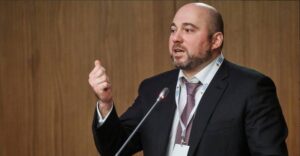
Knauf Gypsum Rock LLC has won the auction for a 20-year special permit for gypsum mining at the Skoviatynske deposit in Ternopil region, according to the results of the bidding on Prozorro.Sale.
Two companies participated in the auction held on Thursday, January 16, by the State Service of Geology and Subsoil of Ukraine, with a starting price of UAH 119 million 608 thousand 594.06 excluding VAT. The winner, Knauf Gypsum Skala LLC, offered UAH 121.05 million excluding VAT for the license, while the second bidder, Kamianets-Podilskyi Gipsovik JSC, offered UAH 120.55 million.
The 115-hectare Skoviatynske deposit is located 1-2 km from the village of Shyshkivtsi in Chortkiv (formerly Borshchiv) district and is the largest in Ternopil region with gypsum reserves of 43.9 million tons. Knauf has been developing the Shyshkovets deposit adjacent to Skoviatynske since 2006. As of 2021, the Shyshkovetsky deposit covered an area of 41 hectares and had reserves of over 11.4 million tons of gypsum.
Knauf is a leading global manufacturer of gypsum and building materials.
Currently, Knauf has an operating plant in Kyiv, which produces about 25 million square meters of gypsum board and 200 thousand tons of dry mixes. Previously, Knauf also owned a plant in Soledar (Donetsk region), which was destroyed by the occupiers. The company took its employees out and employed them at the Kyiv plant, which employs 425 people in total.
As reported, the German company Knauf will build a plant for the production of drywall and dry building mixtures in Borshchiv (Ternopil region), with investments in the project amounting to EUR 150 million, with a design capacity of 30 million square meters of drywall and 320 thousand tons of dry mixtures.
According to Opendatabot, at the end of 2023, the Knauf plant in Kyiv (Knauf Gypsum Kyiv LLC) increased its net income by 65% to UAH 3.53 billion, and net profit by 2.6 times to UAH 1 billion.

For the fifth time, PrivatBank has put up for auction on the Openmarket electronic platform (SE SETAM of the Ministry of Justice of Ukraine) the shopping center “Pryozernyi” in Dnipro, reducing the starting price to UAH 289.3 million (including VAT).
According to the press service of PrivatBank, the lot includes a six-storey shopping center with an area of 32.4 thousand square meters. The facility’s infrastructure also includes an underground parking lot with an equipped shelter.
According to the announcement, the lot also includes 12 land plots. The winning bidder is also obliged to purchase fixed assets worth UAH 2.2 million.
Built in 2009, the Priozerny shopping center is located in the city center near the Central Market and the railway station. The facility includes shopping galleries, office and warehouse space, entertainment and sports areas. The shopping center’s infrastructure includes an underground parking lot for 100 cars and a surface parking lot for 40 cars.
The auction is scheduled for December 20. The guarantee deposit is UAH 14.4 million.
The starting price of the property at the first auction was UAH 430 million.
As reported, in April 2024, the Supreme Court finally confirmed PrivatBank’s ownership of the Priozerny shopping center, upholding the decisions of the courts of first and appellate instances on the legality of the acquisition of ownership of the facility and dismissing the cassation appeal of Mission-1, which the bank associates with its former owners.
Earlier in 2016, PrivatBank acquired ownership of the shopping center as a loan repayment, at which time its value was over UAH 778 million.
Then, in 2021, the former owner of Priozerny, Mission-1 LLC, filed a lawsuit to challenge the state bank’s ownership of the shopping center and return it to its ownership.
The Commercial Court of Dnipropetrovs’k region dismissed the company’s claim, and later, PrivatBank defended the legitimacy of its ownership of the Priozerny shopping center in the Central Economic Court of Appeal (Dnipro).

The State Enterprise Guaranteed Buyer (Guaranteed Buyer) has announced the first auction in Ukraine for the distribution of the green generation support quota.
According to the state enterprise, 11 MW of solar power generation capacity is up for auction, with a starting price of 9 euro cents/kWh.
Applications are accepted until October 30.
The auction itself will be held on October 31 at 12:55 in the state electronic trading system Prozorro.Sale.
The auction will be held with a decreasing price.
According to the auction requirements, the solar power plant must be located on the left bank of the Dnipro River, except for the areas of military operations.
To participate in the auction, a bank guarantee in favor of Guaranteed Buyer in the amount of EUR 5/kW of the power plant’s capacity or its queue must be provided. To sign the contract, the winner of the auction must provide Guaranteed Buyer with a bank guarantee in the amount of EUR 15/kW of capacity, under which the winner is entitled to support based on the results of the auction. The remuneration of the operator of the authorized electronic platform is EUR 0.8/kW.
“The government has created all the conditions for holding the most transparent auctions for the distribution of state support for renewable energy producers. This is another step towards European integration and the implementation of best practices in supporting green energy in Ukraine,” Energy Minister Herman Halushchenko commented on the auction announcement, as quoted in the ministry’s website on Friday.
As reported, the Cabinet of Ministers, by its resolution of August 13, set an additional quota for support for business entities that produce electricity from alternative energy sources in the amount of 110 MW for 2024, of which wind farms – 88 MW, and solar power plants and other types of renewable energy sources (biomass, biogas, small hydropower plants) – 11 MW each.
The SPPs must be located on the left bank of the Dnipro River, and the auction for them will be held in October; there are no territorial restrictions for wind farms and other types, and the auctions are scheduled for November.
The contract with the State Enterprise Guaranteed Buyer for the provision of services under the market premium mechanism with the winner of the auction will be valid for 12 years.
For solar and wind power plants, the maximum selling price for electricity is 9 euro cents/kWh. For other types of alternative energy sources – 12 euro cents/kWh.

The consulting company of the Chairman of the Board of the Amber Business Association of Ukraine won
On Friday, 16.08.2024, an online auction was held for the sale of a special permit for the amber-bearing Polyana field (geological exploration with pilot industrial development and further extraction, for 5 years) with an area of 44.63 hectares in Rivne region.
The bidding started at UAH 4,641,520. Three bidders competed for the lot, with the final bids as follows:
Mykola Kotniuk is the head of the Amber Business Association of Ukraine, which unites 24 participants in the amber industry.
Is the Polyana site worth the UAH 91 million investment in a 5-year special permit? NADRA.INFO asked the winner of the auction.
“Our specialists will conduct a survey of the site, analyze the available geological information, and obtain the conclusions of the legal department on the possibility of obtaining a temporary land plot. After that, the investors will make the final decision on the payment for the lot,” said Mykola Kotnyuk.
If the winner does not buy the special permit, he will lose UAH 2 million of the guarantee fee, and the right to buy it will go to Com Resource LLC.
It should be noted that this was the second attempt by the State Service of Geology and Subsoil of Ukraine to find an investor for the Polyana field. At an auction in July, the lot was valued at UAH 35 million, but the special permit remained unacquired. Then, another company of Mykola Kotnyuk, Ukrainian Amber LLC, offered UAH 22,000,001 for the Polyana plot.
Kom Resurs LLC also participated in the first auction, valuing the lot at UAH 4,710,000. In July, the company was solely controlled by Ivan Debeliy (Antonov, Kryshchenko and Vertyporokh became owners of the company in August.
AMBER, AUCTION, State Service of Geology and Mineral Resources

Tower Group LLC, the beneficiary of which is businessman and politician Vadym Stolar, has purchased the only property complex of the state motor transport enterprise Avtomekhbaza in Kyiv at a privatization auction.
According to information on the Prozorro website, Tower Group offered UAH 80.5 million for the asset at a starting price of UAH 31.9 million (excluding VAT).
The lot includes administrative premises and garages with a total area of about 1.7 thousand square meters, as well as a fleet of cars.
The company’s debt to the budget for the first quarter of 2024 is UAH 528.1 thousand, according to the State Property Fund.
According to Opendatabot, the owners of Tower Group are Genesis (89%) and Phoenix (11%), with Stolar listed as the ultimate beneficiary.

The State Property Fund (SPF) of Ukraine has announced an auction for the privatization of the Ukraina Hotel with a starting price of UAH 1 billion 47.6 million. According to the SPFU press service, applications for participation in the auction scheduled for September 18 will be accepted until September 17. The guarantee fee is UAH 52.3 million.
The lot includes 14 registered units of real estate and infrastructure, including a hotel building; two security buildings; two non-residential buildings; two parking lots, etc. The total area is 26.3 thousand square meters.
According to the results of January-March 2024, the net loss of SE Hotel Ukraine amounted to UAH 3.1 million. In addition, as of March 31, it had wage arrears (UAH 3.8 million), overdue accounts payable (UAH 21 million), and budgetary debts, namely personal income tax (UAH 4.7 million), tourist tax (UAH 1.4 million), and land tax (UAH 4.5 million).
The privatization terms stipulate that the company’s core business (hotel operations) will be maintained for five years, that wage and budget debts will be paid within six months of the transfer of ownership, that social guarantees will be provided to employees in accordance with the law and that they will not be dismissed within six months, and that environmental legislation will be complied with.
As reported, in April, the Cabinet of Ministers of Ukraine included Hotel Ukraina in the list of large-scale privatization objects. In May, the auction commission set the starting price for the privatization of the Ukraina Hotel at UAH 1 billion 47 million 637 thousand 152.
The Ukraine Hotel is a state-owned enterprise managed by the SPFU. The 14-story, 4-star hotel has 363 rooms, six conference halls and meeting rooms. There is a parking lot for 80 cars and a shelter with a separate auditorium for 50 people. The total area of the building is 22.4 thousand square meters.